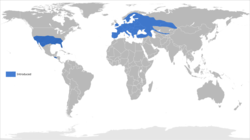| Agelastica alni | |
|---|---|
 | |
| Scientific classification | |
| Kingdom: | Animalia |
| Phylum: | Arthropoda |
| Class: | Insecta |
| Order: | Coleoptera |
| Suborder: | Polyphaga |
| Infraorder: | Cucujiformia |
| Family: | Chrysomelidae |
| Genus: | Agelastica |
| Species: | A. alni |
| Binomial name | |
| Agelastica alni | |
 | |
| Synonyms [1] [2] | |
| |
Agelastica alni, the alder leaf beetle, is a species of leaf beetle (Chrysomelidae) in the genus Agelastica . [3] Agelastica alni is distributed in Europe, the Caucasus, Siberia, north-eastern Kazakhstan, and in the 19th century was introduced to the United States. [4]
Contents
The beetle and the beetle's larval host is the grey or speckled alder (Alnus incana) and to a lesser extent black alder ( Alnus glutinosa ), but it will also be found on hazel, birch or hornbeam [5] if there is a shortage of food. It causes large holes and gaps in leaves from the end of April onwards, which are produced by the larvae in the first two stages, but the main damage is produced by larvae in the third stage.
Previously rare, and considered extinct in the UK, [6] since being found in Manchester in 2004 it appears to be on the increase in the North West of England. Its range has been extending and it was found in Nottinghamshire and Hampshire in 2014 and in North Wales in 2018. [5] [7] This beetle has now been seen in North Yorkshire as of 29-09-24.[ citation needed ] Seen in York as of 15.5.25[ citation needed ]


